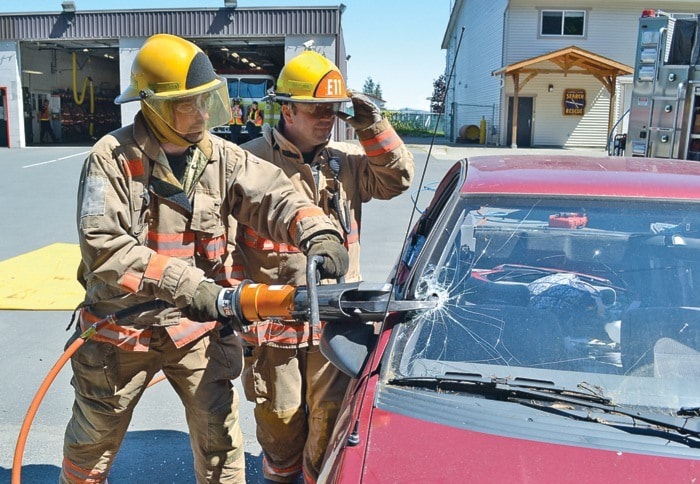It was hot. It was dark. The hose was unwieldy and hauling it and a man’s body out of a “smoky” building was exhausting.
And that’s without the searing heat usually associated with a burning building.
Just dressing me up in the 60 pounds of firefighting gear and sending me into a fire simulation was enough to prove to me that firefighters have a hard job.
Not that I really needed to be convinced of that. After having covered various fires and accidents of the years as a reporter, I was well aware of the challenge our firefighters face.
But in case there was any doubt, I got a taste of just how tough a job it can be during a Campbell River Fire Department media orientation session on Friday.
Four media personnel, a city councillor and two city staffers participated in the orientation session that involved a slide show introduction to the department, a simulated search of a smoking building – including finding and rescuing a “body” while you’re in there – a chance to cut up a car using the “jaws of life,” and an introduction to the 911 system.
Campbell River’s Fire Department (CRFD) has 20 career firefighters based at #1 Fire Station providing 24-hour staffing for a fire engine with four firefighters. It also has 50 auxiliaries – 20 at #1 station (downtown) and 30 at #2 station (Willow Point). The latter are the so-called “volunteer” firefighters, which makes it sound like a Thursday night get together to play with hoses and get in a game of cards afterwards. Their training is far more intense than the simulation I got to experience. Plus they have to go into the real fires when necessary.
There are also 10, 911 fire dispatchers, one fire prevention inspector/firefighter and three chief officers. In 2011, the CRFD responded to 2,053 incidents within 8-13 minutes of receiving the call. The reason they’re able to respond so quickly is because there are four firefighters on duty 24 hours a day.
Those first four firefighters aim to be at the scene in four minutes with the called out firefighters responding within eight minutes.
As you can imagine, rapid response is important when your house is on fire. You frantically put in a call to the 911 dispatch centre to tell them your house is on fire. The 8-13 minutes’ wait for a fire truck to show up will seem like an eternity. Imagine how long you’d have to wait if Campbell River was a purely on-call fire department with no firefighters at the fire station when you placed your panicky call.
Fire Chief Dean Spry said you need a minimum of four firefighters per truck because you need one officer, one driver and two “workers.” Search and fire suppression in fires and/or hazardous environments requires an officer outside directing the action, two firefighters inside and a pump operator in order to do the job safely.
In our first exercise Friday, we were paired up then watched the pros do it first. With Capt. Ken Dawson directing, two firefighters crouched down by the outside door, then opened the door and crawled in. Staying low to the ground, the lead firefighter conducted a search by using his left hand against the wall and circulated around the dark, smoke-filled house (the smoke was actually steam). They then come upon a body which they must then haul out of the house.
Our pros were in and out with minutes. Then it was my turn.
My partner and I were out within minutes. A lot of minutes. I don’t know how many minutes it was. After dragging a firefighter who volunteered to act like a heavy sack of potatoes out of the building, I was ripping my face mask off, desperate for a breath of fresh air because for some reason I thought I would be able catch my breath better if I disconnected the air tank. I didn’t realize that my sealed mask would threaten to suffocate me.
Inside, I and my 60-pounds of firefighter jacket, pants, boots, helmet and breathing gear had tried to search the building, stay crouched down low and haul that blasted fire hose. My partner was, of course, doing the same thing. A yelp from her alerted me to the fact she had found the body. Then it was time to carry him out.
Okay, drag him out.
After that exercise it was ride the fire truck down to #2 station in Willow Point to participate in a car extrication.
At a car crash, four firefighters are needed again. You have the officer, a firefighter in the vehicle with the accident victim and two firefighters extricating the patient. If you wonder why two are needed to extricate, I suggest you grab hold of one of those pneumatic tools ubiquitously known as the “Jaws of Life” and try cutting the door off of a car yourself. Go ahead try it. I did. I could barely lift if after 10 minutes or so of cutting.
It was a demanding and exhilerating exercise but it gave me a mor epersonal insight into what our firefighters have to go through.
It’s not easy but that’s no surprise.
